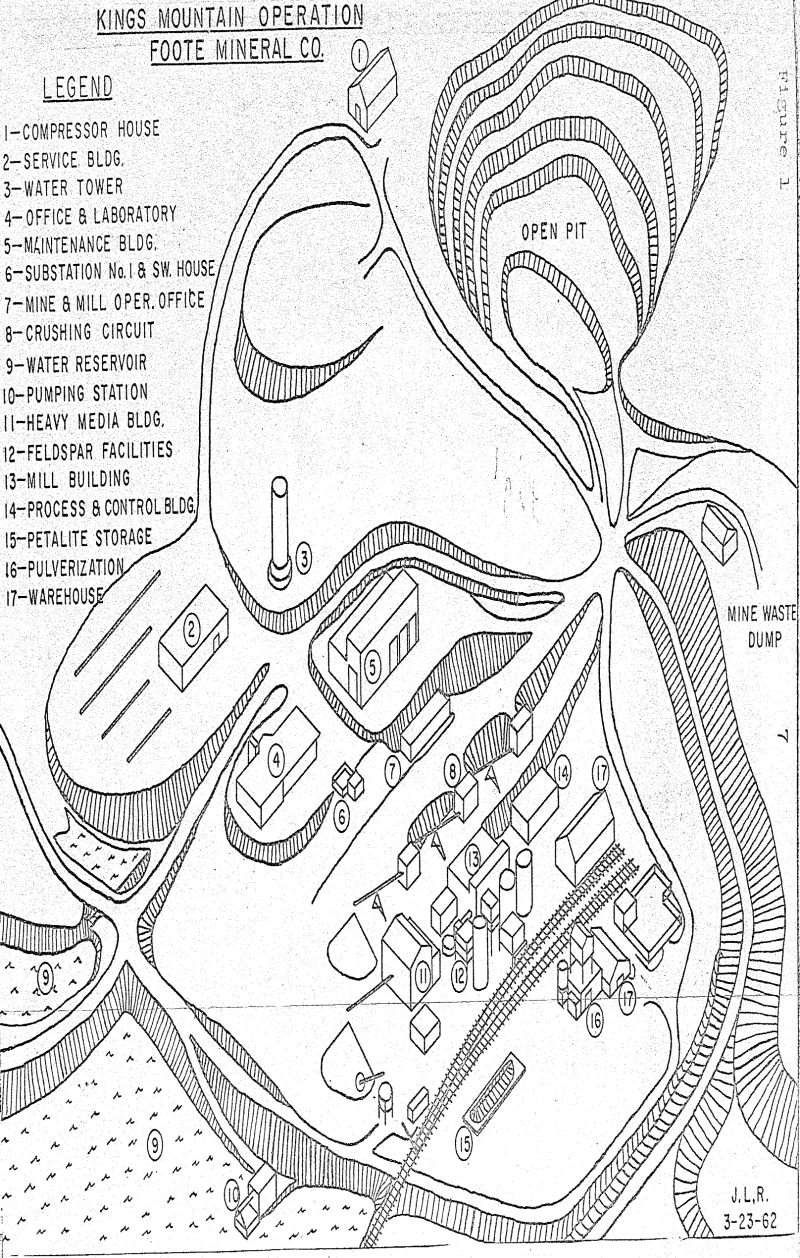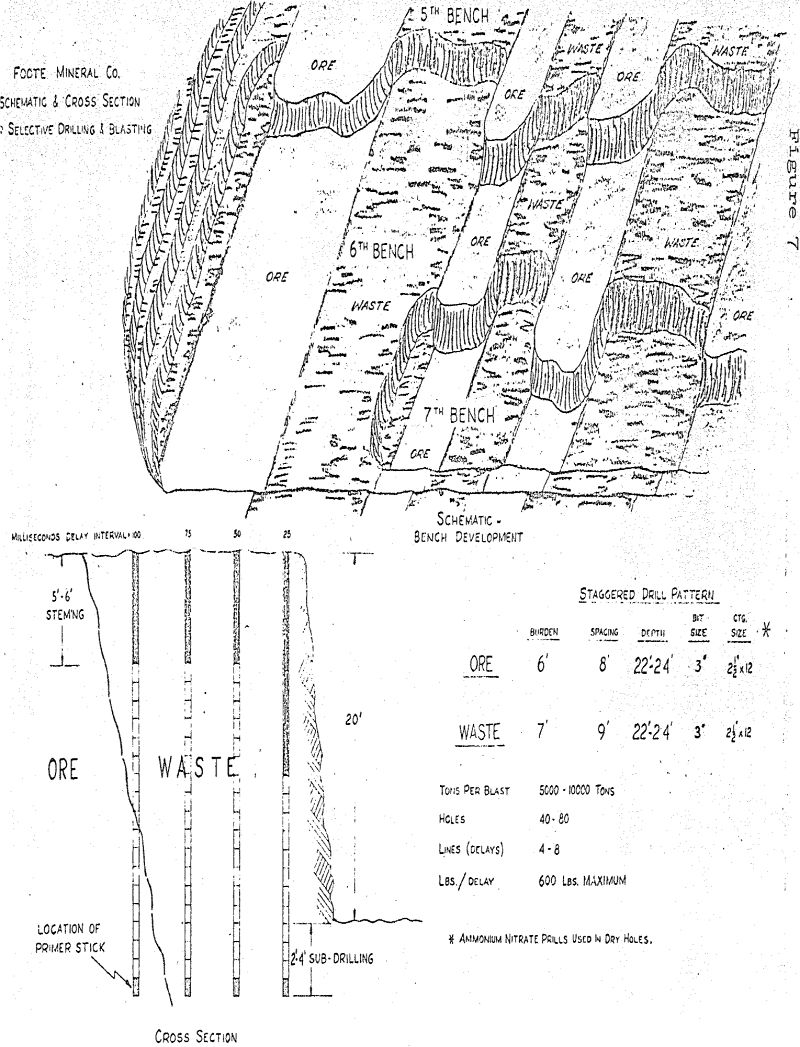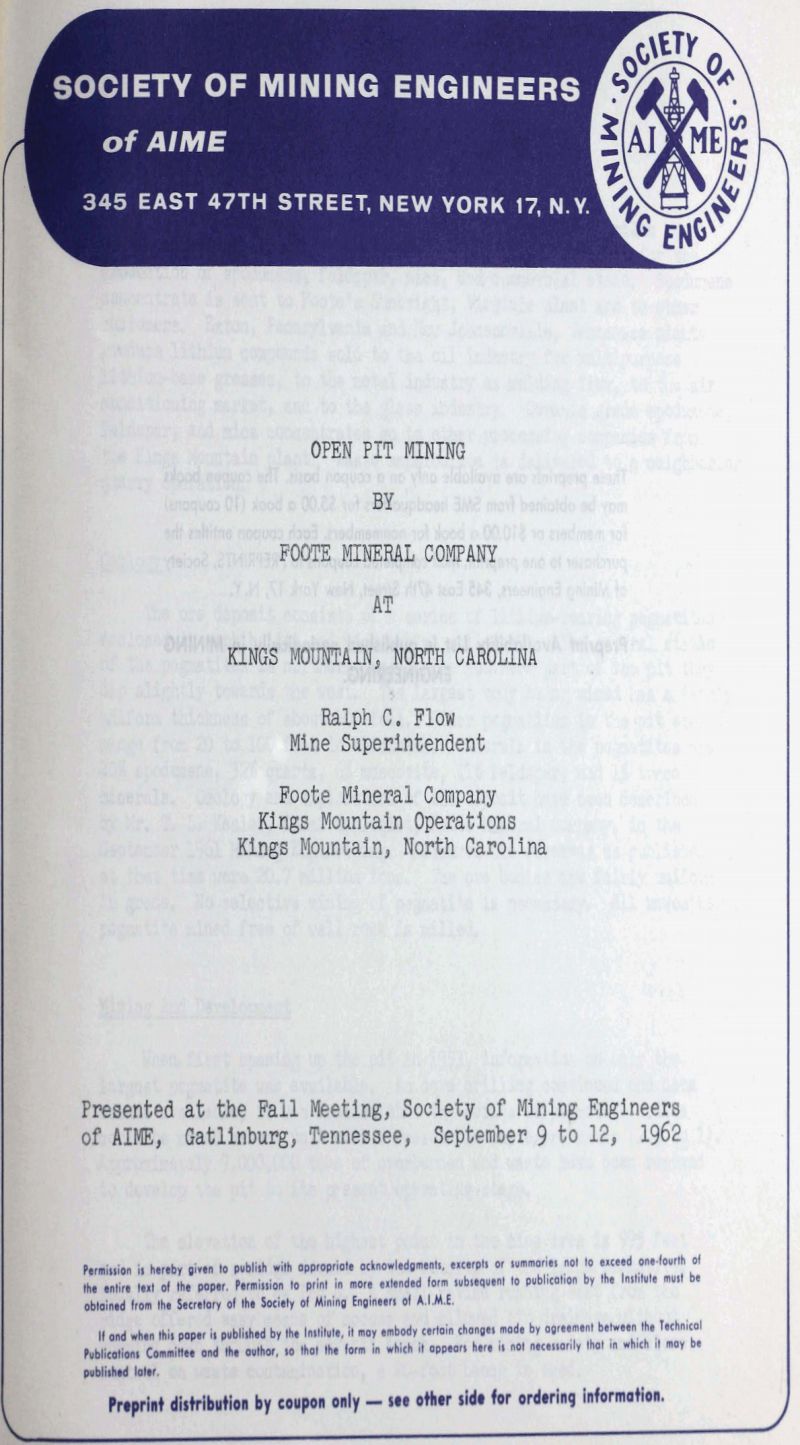Open-pit mining methods are applicable to mining ore deposits that apex at or near the surface. If the deposit apexes below the surface, the overburden and barren capping overlying the ore must be removed in advance of open-pit mining. The removal of this material is known as stripping.
The stripping-pit limits must be extended beyond the limits of the ore pit to provide a bench, and the pit-wall slopes must be such as to prevent sloughing of overburden onto the ore area. Where the ore is to be hauled from the pit by locomotive or trucks, additional excavation is required to provide an approach on a grade suitable for haulage purposes. The cost of this preparatory work is obviously a charge against the cost of mining the ore, each ton of which must bear its proportionate share. As the stripping-ore ratio (volume or tons of overburden and capping to tons of ore made available for open-pit mining) increases, obviously the cost of stripping per ton of ore increases.
The question of whether to mine by open-pit or underground methods is an economic one. The economic limit for open-pit mining is reached when the preparatory and stripping costs per ton of ore plus the open-pit mining cost per ton of ore plus the cost of equipment, interest, and amortization charges equal the cost per ton by mining underground plus equipment and development cost and interest and amortization charges.
The stripping-ore ratio is a basic factor used for determining whether to employ open-pit or underground methods and for determining the economic limits of open-pit mining.
Other factors influencing the choice between open-pit and underground methods may be inferred from the advantages and disadvantages of open-pit mining, some of which are listed below. In specific instances consideration of these may affect the choice of method or result in revision of pit limits established by cost estimates based upon stripping-ore ratios.
Among the advantages of open-pit mining are its flexibility, the ability to obtain mass production with it, and the ease with which rate of production can be increased or decreased once the pit has been developed fully; small shut-down expense; the ability to mine selectively to meet requirements for certain grades of ore (except in glory-hole or milling pits); complete extraction of the ore inside the pit limits (except as limited by ore benches for haulage tracks and maintenance of safe pit slopes, but this ore can usually be recovered finally by employing special clean-up methods); comparatively small number of men employed, a large proportion of whom are skilled labor in mechanized operations; and elimination of hazards inherent in underground mining operations.
On the other hand, certain disadvantages may outweigh the advantages and affect direct economic considerations in some instances. Thus, large open-pit operations involve heavy capital outlay for equipment, and where the amount of overburden to be removed is extensive, correspondingly high capital expenditure is required for stripping. This capital is nonproductive until ore mining is begun, and during the stripping period heavy interest charges often accumulate. The time elapsing before production begins may in itself be a serious disadvantage, especially if exploitation is undertaken at a time when ore prices are favorable and the demand for ore is strong. Disposal of the waste from stripping operations sometimes occasions a serious problem, especially when the terrane is flat or where exorbitant prices must be paid for dump area near the mine. Climatic conditions may limit the operation to being seasonal and necessitate cessation of operations during certain months, and in areas where torrential rains are prevalent frequent flooding of the pit may be a serious obstacle to pit mining.
Simple forms of open-pit ore mining include excavation and loading of overburden and ore by hand into wagons or trucks and excavation and removal of overburden and ore by means of animal-drawn slip or drag scrapers. Such methods are applicable to deposits that are too small to warrant capital investment in mechanical equipment and will not be discussed.
Methods in which “bulldozers” are employed for removal of soil and overburden supplemented by the use of power-operated drag scrapers for excavating (with or without previous preparation by drilling and blasting) are applicable to somewhat larger deposits and will receive some further mention.
Overhead slackline cableways are used extensively in quarries, for sand and gravel excavation, and for other purposes but are not used very extensively for ore mining in this country. This kind of work has been discussed by Thoenen in relation to sand and gravel excavation in an earlier Bureau of Mines publication. Discussion in this bulletin is limited to two principal forms of open-pit mining—glory- hole or milling and power-shovel and dragline mining.
Glory-Hole Or “Milling-Pit” Mining
In glory-hole mining the ore is broken down around one or more raises or mill holes extending upward from an underground haulage-way driven below the ore or beneath the ultimate bottom of the glory hole or pit. The pit is thus in the form of an inverted cone or a series of cones the rims of which finally intersect, and the ultimate rim of the pit will conform in shape to the outlines of the ore body or of that portion of the ore body that is to be mined by this method. The sides of the pit sloping toward the mill hole or raise often are mined in narrow benches, the broken ore being blasted into the pit, whence it is drawn off through the mill holes into cars and trammed or hoisted to the surface. When the slopes of the pit become too flat for the ore to run into the mill holes it becomes necessary to use drag scrapers or other means to transfer it.
The glory-hole method has been used extensively for mining relatively small pipe- or wedge-shaped ore bodies or the upper parts of bodies that apex at or near the surface, and for mining the ore remaining in track benches and in the bottom of power-shovel pits below the elevation where locomotive haulage becomes uneconomical because of adverse track grades. Some stripping of loose overburden or barren cap rock may have to be done before glory-hole mining can be started, possibly by the use of scrapers, dragline excavators, or power shovels, by hydraulicking, or by glory-holing.
The cost of equipment for glory-hole mining usually is much less than for power-shovel work, and for relatively small-scale operations the production cost may be less. For large-scale operations, mining by power shovel usually is cheaper. Glory-hole work is not well-adapted to selective mining as all material within the pit must be blasted down into the mills. Thus, lean ore or waste inclusions within the ore can be taken out and disposed of separately only if the ore is first cleaned from the slopes and bottom of the pit and the mill holes emptied, and then the pit is cleaned and mill holes are emptied again after the waste is blasted out.
At the Britannia mine the glory-hole method was employed in the Bluff ore body (fig. 132), where it was large enough to warrant the use of this method. Glory holes were opened, likewise, in the upper Fairview ore body , where closely spaced parallel veins with some mineralization between them made this method preferable to more expensive selective mining methods. Working benches were 3 feet wide and varied in length. The ore was drawn through grizzly chambers into transfer raises leading to the underground transportation system. In the East Bluff ore body low-grade ore around the glory holes and old stopes was mined by shooting the ore out into the pit, using large charges of explosive placed in coyote drifts driven toward the side of the pit from underground workings.
When the open pit at Sacramento Hill, Bisbee, Ariz., became so deep that hauling ore from the pit was too expensive, the deep ore was mined by glory-holing. In 1929, 574,000 tons and in 1930, 304,000 tons were mined by this method. The bottom of the old pit was oval, about 450 feet long and 400 feet wide. A haulage way 2,000 feet in length and 239 feet below the bottom of the pit was driven from the Sacramento shaft to form a loop under the pit to serve six mill holes, and later five more mills were developed. A grizzly level was driven 135 feet below the pit to connect the mill-hole raises. Grizzly stations or bulldozing chambers were 8 feet wide, 7 feet high, and 15 feet long, and grizzly bars were of 100-pound rails spaced 17 inches apart. Three-compartment L-shaped raises were driven from the grizzly chambers to a height of 90 feet, or within 35 feet of the bottom of the pit. Holes were drilled from the pit over each raise with a churn drill and blasted. Six-inch churn-drill holes, 60 feet deep and 18 to 23 feet apart around the mills, were blasted to funnel the tops of the mills, forming craters, around the slopes of which holes were drilled 18 to 25 feet deep with tripod-mounted pneumatic drills.
Figure 133 is a typical section of a glory hole in the Hilltop ore body at Fresnillo, Zacatecas, Mexico. The first cut in each cycle was taken at the bottom of the crater around the raise, and successive benches 8 to 10 feet high were then mined; the direction of retreat was upward toward the rim. The safe limit of glory-hole slope varies greatly in different localities, but at Fresnillo slopes steeper than 70° were carried safely where they were not more than 100 feet high. Drilling was done with light jackhammers, the holes averaging 9 feet in depth. About 120 feet of hole was drilled per machine shift at a contract price of $0.028 to $0.036, United States currency. The average production per machine shift was 130 tons. The waste to ore ratio was 0.017 to 1.
Figure 134, A, is a cross section of the New Idria (Calif.) ore body, and figure 134, B, is a plan of the 100-foot level of the pit. The stripping was done by glory holing and the ore was then mined by power shovels. The open-cut method was adopted to mine that portion of the ore body between the 300-foot level and surface. Early in 1931 stripping of the hanging-wall waste by glory holing had been in progress for 3 years, during which 1,500,000 tons of rock had been stripped and transferred to the dump by a 42-inch conveyor belt. About 1,500,000 tons remained to be stripped to permit mining to the 300-foot level. To prepare for stripping, a raise was driven in the hanging wall from the 300-foot level to the surface. At a point 27 feet above the level a bulldozing chamber was excavated and grizzlies

installed. From the grizzly the rock was fed to the conveyor belt and transported to the dump; 1,000 tons per hour can be handled, but the normal feeding rate was 350 tons per hour. Distance from center of head pulley to center of tail pulley was 1,250 feet; 670 feet of the belt was in the adit, and the rest extended over the dump.
In the earlier years of open-pit mining on the Mesabi range in Minnesota, a number of milling pits were in operation for mining below levels too deep to be reached by locomotive haulage.
Table 53 presents data on seven typical glory-hole operations.


https://www.911metallurgist.com/history-mining-equipment-practices/
https://www.911metallurgist.com/power-electric-mining-shovel-operation/
Cleveland County, North Carolina, one and one-half miles south of Kings Mountain, Foote Mineral Company operates an open pit for the production of spodumene, feldspar, mica, and commercial stone. Spodumene concentrate is sent to Foote”s Sunbright, Virginia plant and to other customers.
The ore deposit consists of a series of lithium-bearing pegmatites enclosed in amphibolite and mica schist wall rocks. The general strike of the pegmatites is northerly and in the southern part of the pit they dip slightly towards the west. The largest body being mined has a fairly uniform thickness of about 200 feet. Other pegmatites in the pit area range from 20 to 100 feet in thickness.
Drilling is done with three Gardner-Denver drifter drills mounted on air tracs, Holes are 3″ diameter and 22-24 feet in depth on a 6′ x 8′ burden and spacing pattern in ore and 7′ x 9′ in waste. Some blasts have been made with 10-15° inclined holes, but present standard practice is vertical drilling. Presently three different size drifters are in use: one DH-99 (4″ piston); one DH-123 (4½” piston); and one PR-123 (4½” piston – positive rotation).
The average blast consists of approximately 65 holes containing 3,200 pounds of explosives distributed in five or six rows. Explosive ratios range from two tons per pound in ore to over three tons per pound in softer waste shots. The overall average is 2.4- tons per pound.
Ammonium nitrate prills pre-mixed with fuel oil (AN/FO) is purchased in 50-pound bags and as much as possible of this material is used. Due to varying amounts of water, the percentage of AN/FO used differs in each blast.
Properly sized ore is delivered to a 26″ gyratory crusher and secondary breakage of large ore boulders is performed by a dropball. A rubber-tired Osgood crane using a 10,000-pound ball breaks large boulders within reach prior to moving an ore shovel into the pile.
Distance from the center of the pit to the waste dump is a one-way 1.2 mile haul. Distance to the ore and stone crushers is 0.5 miles and 0.6 miles, respectively. Ore is dumped directly into the primary crusher. Stone, sold as mine-run, is delivered to an apron feeder ahead of a 30″ x 42″ jaw crusher. The haulage roads are maintained by a motorgrader and two D-8 bulldozers maintain waste dump and clean-up around shovels.
A Citizen’s’ Band radio communication system has been installed in a portion of mine equipment. This includes a base station at the Mine Office and portable transceivers in the Mine Foreman’s truck and oiler’s jeep. This type system has been inexpensive to install and will be expanded to other equipment as the need arises.



